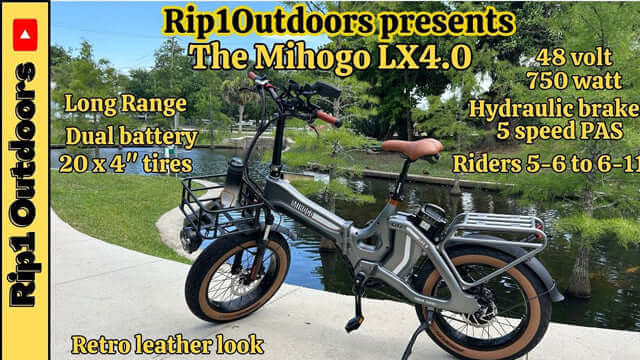The Reality of Dead Battery Riding
When your e-bike battery dies mid-journey, you can simply continue riding as the motor only assists your pedalling rather than doing all the work. However, the experience differs dramatically from riding a conventional bicycle.
Why E-Bikes Feel Harder Without Power
Motor Drag and Resistance
There is noticeable drag somewhere in the drive unit when the motor assistance is switched off, creating what many riders describe as a "pedalling through glue" sensation. This resistance comes from the motor's internal components, even when disengaged.
Significant Weight Difference
Mihogo e-bikes typically weigh between 18-34kg depending on the model:
- Mihogo Mini: Lightweight at approximately 18kg with 350W motor
- Mihogo RX 2.4: Mid-weight at around 25kg with robust dual suspension
- Mihogo Air Max: Carbon fibre construction for reduced weight
- Mihogo ONE Utility: Heaviest for cargo capacity
Compare this to a standard bicycle weighing 10-15kg, and you're carrying an additional 15-25kg when pedalling without assistance.
How Different Mihogo Models Handle Dead Battery Scenarios
Mihogo Mini - Urban Commuter Champion
The Mihogo Mini offers the best dead-battery experience among Mihogo's lineup. Its 350W brushless, gearless, silent aluminium alloy integrated motor and 2.4-inch wide high-grip tyres provide enhanced power and control. The lightweight design means less effort when pedalling unassisted.
Key Features for Manual Riding:
- Five gears for varied terrain adaptation
- Compact, foldable design for easier handling
- Panasonic Semi-Solid Lithium-ion Battery with maximum assist range of 100km
Mihogo RX 2.4 - The All-Rounder
The RX 2.4 presents moderate difficulty when riding with a dead battery. Its detachable 48V 12.8Ah battery pack promises a remarkable range of 50 miles (80km) per charge, but when depleted, the bike's robust build becomes apparent.
Dead Battery Considerations:
- Dual suspension system adds weight but improves comfort
- Shimano 7-speed system facilitates smooth gear shifting for customised power and speed
- 20x2.4" tyres create more rolling resistance without motor assistance
Mihogo Air Max - Carbon Fibre Advantage
With its carbon fibre construction, the Air Max offers the lightest option when riding without power, though specific weight details weren't available in the product specifications.
Tips for Managing Dead Battery Situations
Pre-Ride Planning
Battery Monitoring: Modern Mihogo e-bikes feature intelligent dashboards with battery level indicators. The high-definition IPS display offers comprehensive system monitoring that detects vehicle system faults.
Range Awareness: It's crucial to ensure you always charge your battery before hitting the road and connect your bike's battery to a reliable power source after each ride.
During the Ride
Gear Management: Utilise lower gears more frequently than you would on a regular bicycle. The Shimano gear systems on Mihogo bikes become essential for managing the extra weight and resistance.
Route Planning: Avoid steep hills when possible, as the combined weight and motor drag make climbing significantly more challenging.
European Cycling Infrastructure and Dead Battery Scenarios
The European Union's growing investment in cycling infrastructure makes dead battery scenarios less problematic. The European e-bike battery pack market is growing at a CAGR of 14.5%, with the UK government investing in e-bike infrastructure. This means:
- More charging stations along popular cycling routes
- Better emergency support for stranded cyclists
- Improved cycle paths designed for heavier e-bikes
Future Technology Solutions
Advanced Battery Management
Battery safety is a growing concern, with the U.S. Consumer Product Safety Commission expected to implement stricter safety standards for e-bike manufacturers by mid-2025. These improvements will reduce unexpected battery failures.
Emerging Technologies
Solid-state batteries have the potential to offer energy densities exceeding 300 Wh/kg, allowing for longer ranges and lighter batteries. Future Mihogo models may incorporate these technologies for better dead-battery performance.
Comparing Motor Types and Dead Battery Performance
Hub Motors vs Mid-Drive Systems
Mihogo's hub motor designs generally create less resistance when unpowered compared to mid-drive systems. The integrated motors in models like the Mini are designed to minimise drag during manual pedalling.
Safety Considerations for Dead Battery Riding
Performance Limitations
Without power assistance, expect:
- 40-60% reduction in climbing ability
- Increased stopping distances due to extra weight
- Greater physical exertion, leading to faster fatigue
Emergency Preparedness
Portable Charging Solutions: Consider carrying a portable power bank compatible with your Mihogo model for emergency charging.
Route Planning: Use apps that show elevation profiles and charging station locations along European cycling routes.
Real-World Performance Data
Experienced riders report being able to maintain 25-27km/h on flat tarmac roads with dead batteries, though this requires significantly more effort than riding a conventional bicycle at the same speed.
Maintenance Tips to Prevent Dead Battery Scenarios
Battery Care for Mihogo E-Bikes
Regular Charging: Keep the electric bike battery not 100% fully discharged and charged to maintain optimal battery health.
Temperature Awareness: Store your Mihogo battery indoors during extreme temperatures to preserve capacity and prevent unexpected drainage.
Conclusion
While riding a Mihogo e-bike with a dead battery is significantly harder than riding a conventional bicycle, it remains feasible for most European cycling conditions. The lightweight Mihogo Mini offers the best dead-battery experience, while the RX 2.4 and other models require more planning and physical effort.
The key to managing dead battery scenarios lies in preparation: regular battery maintenance, route planning with charging stations, and understanding your specific Mihogo model's characteristics. As European e-bike infrastructure continues expanding and battery technology advances, these scenarios will become increasingly rare and manageable.
For Mihogo owners, the combination of quality construction, intelligent battery management systems, and European cycling infrastructure makes dead battery riding a manageable inconvenience rather than a major crisis.
External Resources:






